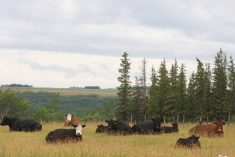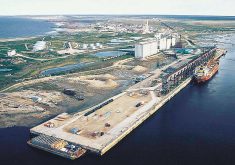The non-farming public, especially in Western Canada, continues to be interested in agriculture and rural life.
Evidence of that can be seen in a pair of features in this week’s issue of the Co-operator.
In the Country Crossroads section, our Lorraine Stevenson writes about the Argyle fall supper, celebrating its 135th anniversary this year.
Every fall, hundreds gather for the community fundraising event that celebrates the bounty of another Manitoba growing season, garnering attendees from far and wide, including a healthy number of folks from the big city just down the road.
Read Also

Introducing the purple tomato
Health Canada has approved bioengineered The Purple Tomato (TM), maybe leading to new culinary uses and health benefits?
You can also find freelance photographer Sandy Black’s contribution in our Sept. 21 issue, documenting the annual Open Farm Day that invites non-farmers to learn more about an industry that helped shape this province and continues to play an important economic and cultural role in its future.
The common theme of both events is the general public’s appetite to attend and support these activities directly, and agriculture itself more indirectly.
One of the big drawing cards is a healthy dose of nostalgia. While few have a direct connection to primary agriculture in this day and age, many have a more distant link to it in the form of parents, grandparents and extended family, sometimes stretching back generations. Even as these links have grown more distant, many remain supportive.
That is both good and bad. As this column has reflected in the past, support built on nostalgia can be a double-edged sword. While it’s great they’re even thinking of farming in the city, often the picture is an outdated one.
Red barns and picturesque pastures are still part of the scene, of course, but they’re not truly representative anymore, as we all know. Most farms are more business-like, which is a fine thing, but just a little less warm and cuddly.
That’s not to say they don’t have a great story to share, and certainly there are lots of efforts to tell that story. A few jump to mind for me that really put the challenges and triumphs of the industry into perspective.
For example, the large grain farms that a certain element of the public like to vilify are in fact a triumph of modern productivity and, increasingly, of sustainability. They feed more people with a smaller land base than even our own parents would have dreamed possible, never mind our grandparents.
And while nobody would ever confuse the crops that are grown on the Prairies with the native grassland habitat they replaced, it’s still important to note the strides that have been made on the sustainability front.
Progress in conservation practices is often overlooked, and should be recognized. Also important, however, is acknowledging there is much work to be done — and farmers won’t be able to do it without the public’s support through research, extension and compensation if productivity suffers. That’s yet another reason telling the story of the industry is so important.
The rise of agriculture, and in particular grain agriculture, is really the story of complex human civilization. Without the ability to grow, harvest and store these dense and transportable foodstuffs, none of the other trappings of human civilization would be possible. It was the creation of food surpluses that allowed some to turn their minds to new challenges and build on this foundation.
But growing annual crops is hard on soil, and eventually depletion of the soil’s organic matter lay at the end of the path, no matter what management techniques were used.
Under the various new tillage regimes, that process has slowed, which creates an opportunity for renewal to begin.
The problem, of course, is that’s a more complex story to tell. But it’s a worthy story and one ‘agvocates’ have in recent years begun to make more widely known.
Another important element to telling the story of modern agriculture is the way the industry seems poised to go even further in the very near future, becoming ever more efficient and sustainable.
The explosion of high-tech equipment promised better placement of inputs and less nutrient run-off. Big datasets may give even more valuable insight into agriculture and how it can be even more of a success story.
A new focus on systemic agriculture, in particularly gaining new prominence at the University of Manitoba, promises to continue to build on the legacy of zero till and the way it leverages natural processes.
This is an important and historic industry with a proud past and a bright future. We should all embrace that fact and do what we can to share this story.















